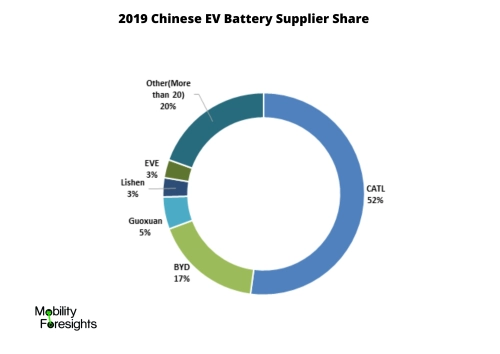China is the current market leader for EV batteries in terms of volume with China producing 58% out of 108 GWh of the global lithium ion battery manufacturing for electric vehicles in 2019.
Out of the 2.2 million electric cars sold in 2019, China was responsible for 1.15 million of them.
Thatâs more than 50% of the electric car sales. 0.2 million CVs were sold by the Chinese OEMs. According to a recent analysis, automakers are investing $135 billion to develop EVs and EV batteries in China over the next 5 to 10 years.
Driving Force
Major Players
 The Chinese market has many manufacturers both internal and external. CATL, BYD, and Guoxuan are the main internal manufacturers who supply to the Chinese OEMs. Panasonic, LG Chem, and Samsung SDI have plants in China and can supply to both Chinese and non-Chinese OEMs as the recommended battery list has been scrapped.
The Chinese manufacturers such as CATL, BYD are setting up plants throughout the globe and also establishing undertaking cell/battery pack supply for various OEMs like Volvo, Tesla, etc.
Non-Chinese OEMs in China and effect on the Chinese battery market
The Chinese market is the largest automobile market in the World in terms of volume as it sold 28.8 million units in 2018 alone. Major OEMs generate a lot of their revenue from China alone, for example, Volkswagen sells about 40% of its output in China. The size of the market has led to multiple joint ventures by global OEMs with Chinese companies to manufacture and sell in China and also for export purposes. As OEMs look into EV platforms for the future, the battery supply, especially in the Chinese manufacturing plants, looks like itâll be managed by Chinese battery manufacturers. The smart logistics for battery supply is to set up a battery plant near the automobile plant and for this reason, Panasonic, LG Chem, Samsung SDI are setting up plants in China.
Future of EVs in China post-subsidy cuts and its effect on the Chinese battery market
Popular OEMs have already set up plants in China and Tesla is a new addition to this with its factory in Shangai. The government subsidies helped in drawing customers to explore EVs but post-subsidy appeal, supporting infrastructure and value for money offered by the EVs will be the alluring factor to draw customers. It also helps OEMs that the global decrease in battery pricing also helps in the overall EV price decrease which means that soon Electric and ICE vehicles will be of comparable pricing. This will be a boon for battery suppliers as the public tendency can shift towards EV primarily due to lower running costs and maintenance.
What NOW?
Though there is a decline in EV sales post-subsidy reduction, the market looks towards EVs so does the focus of OEMs. Battery manufacturers are increasing the volume of production, improving the efficiency of their supply chains and also improving batteries in terms of energy density, safety, and cost aspects. Major Chinese cities have a growing EV supporting infrastructure and the Chinese battery manufacturers are also looking into battery recycling/reusing with BYD already opening a battery recycling plant. The future tends to favour the EV side of the balance and the battery manufacturers will need to keep up with the demand both local and global.
The information has been sourced from our report titled âGlobal Electric Vehicle Battery Market 2019-2025â.  Download free sample to know more
WRITTEN BY
 Rijo Joseph , Research Associate at Mobility Foresights  Â








